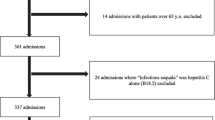Abstract
This study aimed to investigate the prevalence of potential unnecessary injection (PUNI) and to identify factors associated with frequent PUNI uses. Population-based National Health Insurance claims data for outpatient health care settings during the six month period from July to December 2011 were retrospectively reviewed. Patients aged 18–80 without severe diseases and visited healthcare centers more than 25 times during study period were included. PUNI was defined as injection used where substitutable oral agents were available and where injection uses are not warranted. A total of 801,532 patients were included for this analysis. Among them, 29.0 % were frequent PUNI user defined as ≥10 PUNI used during the study period. In multivariate logistic regression results revealed significant associations between frequent PUNI use and several patient and healthcare utilization factors. Women than men, elderly than younger people, residents in rural areas than in big cities, and more frequent visitors to healthcare centers than less frequent visitors were more likely to be frequent PUNI users. Larger number of healthcare center utilized and higher out-of-pocket expense level showed significant lower risks of frequent PUNI uses. Identified factors associated with frequent PUNI use in this study could be the targets to develop programs for reducing injection overuse.

Similar content being viewed by others
References
Abkar, M.A., I.M. Wahdan, A.A. Sherif, and Y.A. Raja’a. 2013. Unsafe injection practices in Hodeidah governorate, Yemen. Journal of Infection and Public Health 6: 252–260.
Barnes, M.G., C. Ledford, and K. Hogan. 2012. A “needling” problem: shoulder injury related to vaccine administration. Journal of the American Board of Family Medicine 25: 919–922.
Choi, K.H., S.M. Park, J.H. Lee, and S. Kwon. 2012. Factors affecting the prescribing patterns of antibiotics and injections. Journal of Korean Medical Science 27: 120–127.
Dong, L., D. Wang, J. Gao, and H. Yan. 2011. Doctor’s injection prescribing and its correlates in village health clinics across 10 Provinces of Western China. Journal of Public Health (Oxford) 33: 565–570.
Dziekan, G., D. Chisholm, B. Johns, J. Rovira, and Y.J. Hutin. 2003. The cost-effectiveness of policies for the safe and appropriate use of injection in healthcare settings. Bulletin of the World Health Organization 81: 277–285.
Fiechter, R., M. Batschwaroff, and D. Conen. 2005. Anaphylactic reaction after Fe-injection. Praxis 94: 209–212.
Gupta, E., M. Bajpai, P. Sharma, A. Shah, and S. Sarin. 2013. Unsafe injection practices: a potential weapon for the outbreak of blood borne viruses in the community. Annals of Medical and Health Sciences Research 3: 177–181.
Gyawali, S., D.S. Rathore, P.R. Shankar, and K.V. Kumar. 2013. Strategies and challenges for safe injection practice in developing countries. Journal of Pharmacology and Pharmacotherapeutics 4: 8–12.
Health Insurance Review and Assessment Service. 2012. Evaluations on Drug Reimbursement Appropriateness in the first half of 2012.
Hwang, J.H., D.S. Kim, S.I. Lee, and J.I. Hwang. 2007. Relationship between physician characteristics and their injection use in Korea. International Journal for Quality in Health Care 19: 309–316.
Kahn, L.H., and B.A. Styrt. 1997. Necrotizing soft tissue infections reported with nonsteroidal antiinflammatory drugs. Annals of Pharmacotherapy 31: 1034–1039.
Kaipilyawar, S.B. 2005. History, magnitude and rationality of injection use–a compilation. Journal of the Indian Medical Association 103: 206–208.
Kim, D.S., J.H. Hwang, and J.I. Hwang. 2012. A multi-level analysis of injection requests and associated patient characteristics in the Korean acute-care outpatient setting. Korean Journal of Clinical Pharmacy 22: 13–20.
Kotwal, A. 2005. Innovation, diffusion and safety of a medical technology: a review of the literature on injection practices. Social Science and Medicine 60: 1133–1147.
Lee, I.H., S. Park, and E.K. Lee. 2014. Sociodemographic factors influencing the use of injections in South Korean outpatient care. Pharmacoepidemiology and Drug Safety 23: 51–59.
Logez, S., G. Soyolgerel, R. Fields, S. Luby, and Y. Hutin. 2004. Rapid assessment of injection practices in Mongolia. American Journal of Infection Control 32: 31–37.
Mclaws, M.L., S. Ghahramani, C.J. Palenik, V. Keshtkar, and M. Askarian. 2014. Assessment of injection practice in primary health care facilities of Shiraz, Iran. American Journal of Infection Control. doi:10.1016/j.ajic.2013.09.006.
National Health Insurance Service, Health Insurance Review & Assessment Service. 2013. National Health Insurance Statistical Yearbook 2012. Seoul.
Rajasekaran, M., G. Sivagnanam, P. Thirumalaikolundusubramainan, K. Namasivayam, and C. Ravindranath. 2003. Injection practices in southern part of India. Public health 117: 208–213.
Ramtahal, J., S. Ramlakhan, and K. Singh. 2006. Sciatic nerve injury following intramuscular injection: a case report and review of the literature. Journal of Neuroscience Nursing 38: 238–240.
Reynolds, L., and M. Mckee. 2011. Serve the people or close the sale? Profit-driven overuse of injections and infusions in China’s market-based healthcare system. International Journal of Health Planning and Management 26: 449–470.
Schwartz, N.A., M.A. Turturro, D.J. Istvan, and G.L. Larkin. 2000. Patients’ perceptions of route of nonsteroidal anti-inflammatory drug administration and its effect on analgesia. Academic Emergency Medicine 7: 857–861.
Shatsky, M. 2009. Evidence for the use of intramuscular injections in outpatient practice. American Family Physician 79: 297–300.
Simonsen, L., A. Kane, J. Lloyd, M. Zaffran, and M. Kane. 1999. Unsafe injections in the developing world and transmission of bloodborne pathogens: a review. Bulletin of the World Health Organization 77: 789–800.
Vong, S., J.F. Perz, S. Sok, S. Som, S. Goldstein, Y. Hutin, and J. Tulloch. 2005. Rapid assessment of injection practices in Cambodia, 2002. BMC public health 5: 56.
Acknowledgments
We thank the National Health Insurance Service for providing us with the NHI data for this study. This work was supported by the NHIS (2012).
Conflict of interest
All authors certify that there is no conflict of interest with any financial, personal or other relationships with other people or organizations that could inappropriately influence or be perceived to influence this study.
Author information
Authors and Affiliations
Corresponding author
Rights and permissions
About this article
Cite this article
Sohn, H.S., Jang, S., Han, E. et al. Patient factors affecting frequent potential unnecessary injection use in outpatient care setting. Arch. Pharm. Res. 38, 1389–1396 (2015). https://doi.org/10.1007/s12272-014-0406-5
Received:
Accepted:
Published:
Issue Date:
DOI: https://doi.org/10.1007/s12272-014-0406-5



